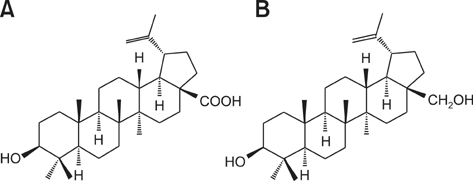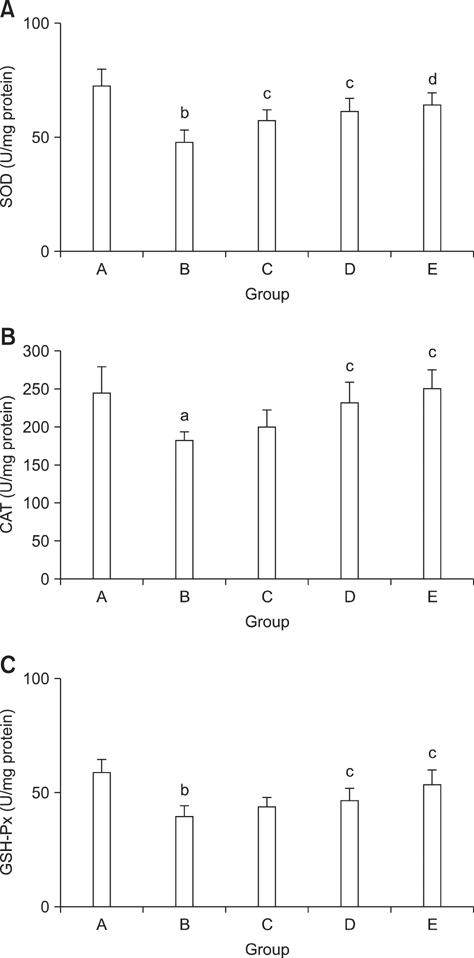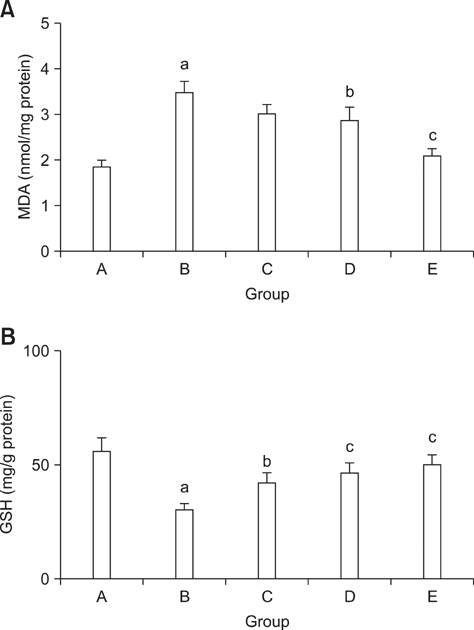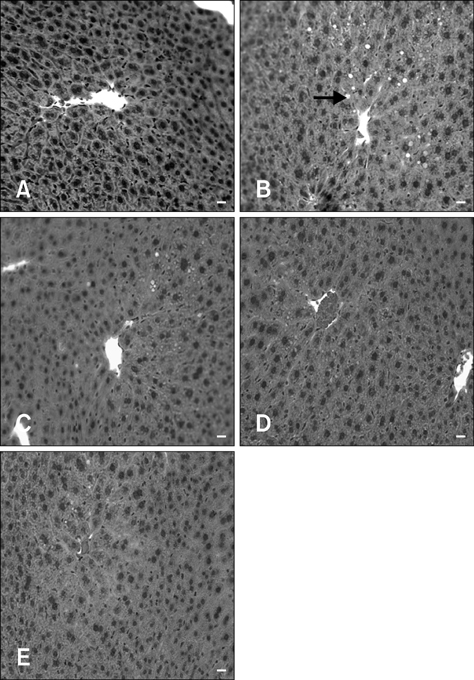J Vet Sci.
2014 Mar;15(1):141-148. 10.4142/jvs.2014.15.1.141.
Betulinic acid prevents alcohol-induced liver damage by improving the antioxidant system in mice
- Affiliations
-
- 1College of Veterinary Medicine, Hunan Agricultural University, Changsha 410128, China. yijine@gmail.com
- 2College of Bioscience and Biotechnology, Hunan Agricultural University, Changsha 410128, China.
- 3Department of Agricultural, Food and Nutritional Science, Faculty of Agricultural, Life and Environmental Sciences, University of Alberta, Edmonton, T6G 2P5, Canada.
- KMID: 1737620
- DOI: http://doi.org/10.4142/jvs.2014.15.1.141
Abstract
- Betulinic acid (BA), a pentacyclic lupane-type triterpene, has a wide range of bioactivities. The main objective of this work was to evaluate the hepatoprotective activity of BA and the potential mechanism underlying the ability of this compound to prevent liver damage induced by alcohol in vivo. Mice were given oral doses of BA (0.25, 0.5, and 1.0 mg/kg) daily for 14 days, and induced liver injury by feeding 50% alcohol orally at the dosage of 10 ml/kg after 1 h last administration of BA. BA pretreatment significantly reduced the serum levels of alanine transaminase, aspartate transaminase, total cholesterol, and triacylglycerides in a dose-dependent manner in the mice administered alcohol. Hepatic levels of glutathione, superoxide dismutase, glutathione peroxidase, and catalase were remarkably increased, while malondialdehyde contents and microvesicular steatosis in the liver were decreased by BA in a dose-dependent manner after alcohol-induced liver injury. These findings suggest that the mechanism underlying the hepatoprotective effects of BA might be due to increased antioxidant capacity, mainly through improvement of the tissue redox system, maintenance of the antioxidant system, and decreased lipid peroxidation in the liver.
MeSH Terms
Figure
Reference
-
1. Ashkenazi A, Dixit VM. Apoptosis control by death and decoy receptors. Curr Opin Cell Biol. 1999; 11:255–260.
Article2. Berg D, Lehne M, Müller N, Siegmund D, Münkel S, Sebald W, Pfizenmaier K, Wajant H. Enforced covalent trimerization increases the activity of the TNF ligand family members TRAIL and CD95L. Cell Death Differ. 2007; 14:2021–2034.
Article3. Brandon-Warner E, Schrum LW, Schmidt CM, McKillop IH. Rodent models of alcoholic liver disease: of mice and men. Alcohol. 2012; 46:715–725.
Article4. Brenner C, Cadiou H, Vieira HLA, Zamzami N, Marzo I, Xie Z, Leber B, Andrews D, Duclohier H, Reed JC, Kroemer G. Bcl-2 and Bax regulate the channel activity of the mitochondrial adenine nucleotide translocator. Oncogene. 2000; 19:329–336.
Article5. Cook RT. Alcohol abuse, alcoholism, and damage to the immune system-a review. Alcohol Clin Exp Res. 1998; 22:1927–1942.
Article6. Crabb DW. Recent developments in alcoholism: the liver. Recent Dev Alcohol. 1993; 11:207–230.7. D'Alessio M, Cerella C, De Nicola M, Bergamaschi A, Magrini A, Gualandi G, Alfonsi AM, Ghibelli L. Apoptotic GSH extrusion is associated with free radical generation. Ann N Y Acad Sci. 2003; 1010:449–452.8. de Melo CL, Queiroz MGR, Arruda Filho ACV, Rodrigues AM, de Sousa DF, Almeida JGL, Pessoa ODL, Silveira ER, Menezes DB, Melo TS, Santos FA, Rao VS. Betulinic acid, a natural pentacyclic triterpenoid, prevents abdominal fat accumulation in mice fed a high-fat diet. J Agric Food Chem. 2009; 57:8776–8781.
Article9. Flekhter OB, Nigmatullina LR, Baltina LA, Karachurina LT, Galin FZ, Zarudii FS, Tolstikov GA, Boreko EI, Pavlova NI, Nikolaeva SN, Savinova OV. Synthesis of betulinic acid from betulin extract and study of the antiviral and antiulcer activity of some related terpenoids. Pharm Chem J. 2002; 36:484–487.10. Fujioka T, Kashiwada Y, Kilkuskie RE, Cosentino LM, Ballas LM, Jiang JB, Janzen WP, Chen IS, Lee KH. Anti-AIDS agents, 11. Betulinic acid and platanic acid as anti-HIV principles from Syzigium claviflorum, and the anti-HIV activity of structurally related triterpenoids. J Nat Prod. 1994; 57:243–247.
Article11. Fulda S. Betulinic acid: a natural product with anticancer activity. Mol Nutr Food Res. 2009; 53:140–146.
Article12. Gao B, Bataller R. Alcoholic liver disease: pathogenesis and new therapeutic targets. Gastroenterology. 2011; 141:1572–1585.
Article13. Gramenzi A, Caputo F, Biselli M, Kuria F, Loggi E, Andreone P, Bernardi M. Review article: alcoholic liver disease-pathophysiological aspects and risk factors. Aliment Pharmacol Ther. 2006; 24:1151–1161.
Article14. Jain M, Kapadia R, Jadeja RN, Thounaojam MC, Devkar RV, Mishra SH. Hepatoprotective potential of Tecomella undulate stem bark is partially due to the presence of betulinic acid. J Ethnopharmacol. 2012; 143:194–200.
Article15. Kong Q, Qin C. Analysis of current laboratory animal science policies and administration in China. ILAR J. 2009; 51:e1–r10.
Article16. Mandal D, Mazumder A, Das P, Kundu M, Basu J. Fas-, Caspase 8-, and Caspase 3-dependent signaling regulates the activity of the aminophospholipid translocase and phosphatidylserine externalization in human erythrocytes. J Biol Chem. 2005; 280:39460–39467.
Article17. Marsano LS, Mendez C, Hill D, Barve S, McClain CJ. Diagnosis and treatment of alcoholic liver disease and its complications. Alcohol Res Health. 2003; 27:247–256.18. Mato JM, Cámara J, Fernández de Paz J, Caballería L, Coll S, Caballero A, García-Buey L, Beltrán J, Benita V, Caballería J, Solá R, Moreno-Otero R, Barrao F, Martín-Duce A, Correa JA, Parés A, Barrao E, García-Magaz I, Puerta JL, Moreno J, Boissard G, Ortiz P, Rodés J. S-adenosylmethionine in alcoholic liver cirrhosis: a randomized, placebo-controlled, double-blind, multicenter clinical trial. J Hepatol. 1999; 30:1081–1089.
Article19. Nanji AA, Jokelainen K, Rahemtulla A, Miao L, Fogt F, Matsumoto H, Tahan SR, Su GL. Activation of nuclear factor kappa B and cytokine imbalance in experimental alcoholic liver disease in the rat. Hepatology. 1999; 30:934–943.
Article20. Neff GW, Duncan CW, Schiff ER. The current economic burden of cirrhosis. Gastroenterol Hepatol (N Y). 2011; 7:661–671.21. Nishitani Y, Matsumoto H. Ethanol rapidly causes activation of JNK associated with ER stress under inhibition of ADH. FEBS Lett. 2006; 580:9–14.
Article22. Pisha E, Chai H, Lee IS, Chagwedera TE, Farnsworth NR, Cordell GA, Beecher CWW, Fong HHS, Kinghorn AD, Brown DM, Wani MC, Wall ME, Hieken TJ, Das Gupta TK, Pezzuto JM. Discovery of betulinic acid as a selective inhibitor of human melanoma that functions by induction of apoptosis. Nat Med. 1995; 1:1046–1051.
Article23. Raghu R, Liu CT, Tsai MH, Tang X, Kalari KR, Subramanian S, Sheen LY. Transcriptome analysis of garlic-induced hepatoprotection against alcohol fatty liver. J Agric Food Chem. 2012; 60:11104–11119.
Article24. Recio MC, Giner RM, Máñez S, Gueho J, Julien HR, Hostettmann K, Ríos JL. Investigations on the steroidal anti-inflammatory activity of triterpenoids from Diospyros leucomelas. Planta Med. 1995; 61:9–12.
Article25. Rehm J, Mathers C, Popova S, Thavorncharoensap M, Teerawattananon Y, Patra J. Global burden of disease and injury and economic cost attributable to alcohol use and alcohol-use disorders. Lancet. 2009; 373:2223–2233.
Article26. Steinkamp-Fenske K, Bollinger L, Xu H, Yao Y, Horke S, Förstermann U, Li H. Reciprocal regulation of endothelial nitric-oxide synthase and NADPH oxidase by betulinic acid in human endothelial cells. J Pharmacol Exp Ther. 2007; 322:836–842.
Article27. Sun F, Xie ML, Zhu LJ, Xue J, Gu ZL. Inhibitory effect of osthole on alcohol-induced fatty liver in mice. Dig Liver Dis. 2009; 41:127–133.
Article28. Szuster-Ciesielska A, Kandefer-SzerszeXMLLink_XYZ M. Protective effects of betulin and betulinic acid against ethanol-induced cytotoxicity in HepG2 cells. Pharmacol Rep. 2005; 57:588–595.29. Szuster-Ciesielska A, Plewka K, Daniluk J, Kandefer-SzerszeXMLLink_XYZ M. Betulin and betulinic acid attenuate ethanol-induced liver stellate cell activation by inhibiting reactive oxygen species (ROS), cytokine (TNF-α, TGF-β) production and by influencing intracellular signaling. Toxicology. 2011; 280:152–163.
Article30. Vyssokikh MY, Zorova L, Zorov D, Heimlich G, Jürgensmeier JJ, Brdiczka D. Bax releases cytochrome c preferentially from a complex between porin and adenine nucleotide translocator. Hexokinase activity suppresses this effect. Mol Biol Rep. 2002; 29:93–96.31. Wang M, Zhu P, Jiang C, Ma L, Zhang Z, Zeng X. Preliminary characterization, antioxidant activity in vitro and hepatoprotective effect on acute alcohol-induced liver injury in mice of polysaccharides from the peduncles of Hovenia dulcis. Food Chem Toxicol. 2012; 50:2964–2970.
Article32. Yi J, Obminska-Mrukowicz B, Yuan L, Yuan H. Immunomodulatory effects of betulinic acid from the bark of white birch on mice. J Vet Sci. 2010; 11:305–313.
Article33. Yogeeswari P, Sriram D. Betulinic acid and its derivatives: a review on their biological properties. Curr Med Chem. 2005; 12:657–666.
Article34. Yoon JJ, Lee YJ, Kim JS, Kang DG, Lee HS. Protective role of betulinic acid on TNF-α-induced cell adhesion molecules in vascular endothelial cells. Biochem Biophys Res Commun. 2010; 391:96–101.
Article35. Yu HY, Wang BL, Zhao J, Yao XM, Gu Y, Li Y. Protective effect of bicyclol on tetracycline-induced fatty liver in mice. Toxicology. 2009; 261:112–118.
Article36. Yuan HD, Jin GZ, Piao GC. Protective effects of the supernatant of ethanol eluate from Artemisia sacrorum ledeb. against acetaminophen-induced liver injury in mice. Biol Pharm Bull. 2009; 32:1683–1688.
Article37. Zhang ZF, Fan SH, Zheng YL, Lu J, Wu DM, Shan Q, Hu B. Troxerutin protects the mouse liver against oxidative stress-mediated injury induced by D-Galactose. J Agric Food Chem. 2009; 57:7731–7736.
Article38. Zheng ZW, Song SZ, Wu YL, Lian LH, Wan Y, Nan JX. Betulinic acid prevention of D-galactosamine/ lipopolysaccharide liver toxicity is triggered by activation of Bcl-2 and antioxidant mechanisms. J Pharm Pharmacol. 2011; 63:572–578.
Article
- Full Text Links
- Actions
-
Cited
- CITED
-
- Close
- Share
- Similar articles
-
- Studies on In Vivo Function of Peroxiredoxins in Knockout Mice
- Anti-Influenza Activity of Betulinic Acid from Zizyphus jujuba on Influenza A/PR/8 Virus
- Effects of the Sanjoin on the Rat Brain: Focused on Serotonin, Sleeping Time, Sleep EEG and Autonomic Activity
- Anti-inflammatory and antioxidant effects of umbelliferone in chronic alcohol-fed rats
- Effect of Betulinic Acid on MUC5AC and MUC5B Expression in Airway Epithelial Cells





